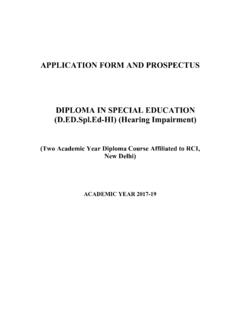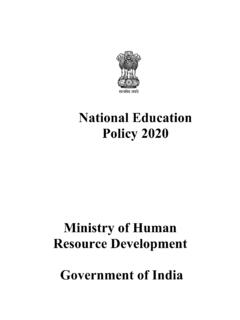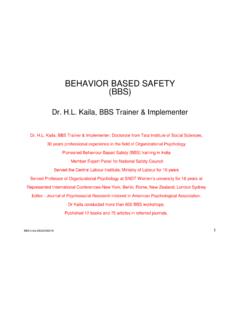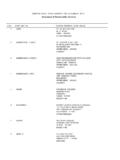Transcription of Joyanthi Narayan - NIEPID
1 Sk___ ,,/ Joyanthi NarayanFJustice and Emprnent, Govt, of India)asnigar, Secundercjbad - 500 009 Andhro Pradesh, INDIAGRADE LEVEL ASSESSMENT DEVICEFOR CHILDREN WITH LEARNING PROBLEMS IN SCHOOLSP roject funded by ICSSRJ ayanthi NarayanNATIONAL INSTITUTE FOR THE MENTALLY HANDICAPPED(Ministry of Social Justice and Empowerment, Govt. of India)Manovikasnagar, Secunderabad - 500 009. AndhraPradesh,INDIAP hone : 27751741 Fax : 040-277501 98E-mail : Website : N!MH, 2003 (NIMH)The project on which the present report is based was funded by the Indian Councilof Social Science Research. However,the responsibility for the facts stated, opinionsexpressed, and conclusions reached is entirely that of the project director/authorand not of the Indian Council of Social Science work was evaluated by Dr.
2 On behalf of the NarayanProject AssistantISBN81-86594-06-XCoverDesign Ravi KumarThe 'Square peg in a round hole' depicts efforts towards fitting childrenwith learning problems in regular at Sree Ramana Process Pvt. Ltd., Secunderabad. Ph: 040- place on record my gratitude to Indian Council of SocialScience Research for funding the project. I thank Dr. Menon,Director of NIMH immensely for permitting to carry out theproject and to have provided the support at all stages. I thankShri L. Govinda Rao Deputy Director (Admn.), Shri T. Pitchaiah,Accounts Officer, Shri G. V. Reddy Asst. Admn. Officer (Acad.)
3 And the industrious staff of Department of AdministratiQn forextending support for the project. The meticulous secretarialassistance provided all the way through the project by Mr. Rao is gratefully acknowledged. The assistancerendered by Mrs. Suneeta Burder, Clinical Assistant in thedevelopment of the tool, Mr. Srikanth for the data analysisand statistical assistance and Mrs. K. Aruna, Clinical Assistant, Kishore and Ms. Pragya Srivastav for careful proof readingare gratefully acknowledged. Last but not the least the schoolsnamely, Diamond Jubilee School, Hyderabad; Sherwood PublicSchool, Secunderabad; Ivy League Academy, Shamirpet; St.
4 IgnatiusSchool, Gagillapuram and ,Lakshman Public School, Delhi, who havewillingly participated in the research project and cooperated allthrough the field work, are appreciated for their assistance andgratitude is placed on NarayanONE MOMENT second print of GLAD thatyou are holdingnow has certain minor revision and modifications, basedon tfie comments and suggestions from the users. Iwould like to thank all the primary school teachers,teacher educators and resource room teachers fromvarious parts of the country who have contributed tothis effort. The overwhelming demand for the GLAD only shows that teachers are eager to help childrenwith learning problems in primary schools thusfocussing on 'Education For All' with appropriatesupport to the 'weak' students in the I welcome suggestions for further efforts, Ionce again thank all those who have given constructivefeedback contributing to better version of this NaroyanCONTENTSTHE TOOLPage to Learning Problems OverviewI toVIFormat IClass IEnglishHindi33 Mathematics55(including separate scoring sheets)Class IIEnglish77 Hindi95 Mathematics107(including separate scoring sheets)
5 Class IllEnglish123 Hindi137 MathematicsI 5 I(including separate scoring sheets)Class IVEnglish163 Hindi175 MathematicsI 9 I(including separate scoring sheets)Recording Format II203 MANUALD evelopment of Tool211 Instructions to use the tool222 Recording Format II - Filled sample228 References235 Appendices236 TheloolFormat IHindi and Maths17 English,INTRODUCTION LEARNING PROBLEMS - AN OVERVIEWThe number of children enrolled in schools has increased in the past decade withthe awareness on importance of education. However, many children drop out from schools,due to poor scholastic performance. When the skills in selfhelp, motor, communicationand social areas are appropriately performed by the child and he is found to be poor onlyIn academic aspects to such an extent that he is unsuitable to the age appropriate class,itbecomes a concern to the problem in the child may not be due to intellectualimpairment alone, but due to other problems, in the learning are a number of learners who have difficulty in processing information that ispresented to them auditorily or visually.
6 Some cannot learn efficiently when their auditory,visual, and tactual-kinesthetic processes are not synchronized to operate as a functional unitwhen attempting to learn or perform a particular task. By the same token, learning occurseffectively in many children who have moderate deficiencies in certain processes thatinvolveperception, imagery, language, and motor abilities while others who are only mildlyinvolvedfail at the same tasks. One explanation could be that the former compensates more effectivelyfor the disability (Mann & Suiter, I 978). It becomes necessary not only to identify but alsoremediate the children with scholastic is recommended that both, the student's strenghts.
7 And weaknesses be considered insetting up an instructional program. The teacher must be responsive tothe needs of term "open channel" is familiarly associated with Anne Sullivan who discoveredthat Helen Keller could learn through her hand. The teacher must "decode" thestudent todiscover the open channels, and, open closed channels whenever possible for more integratdliming. The teacher must work concomitantly with the strenghts atthe task level as well aswith the deficits in the daily educational program (Mann & Suiter, 1978).To do so effectively,itis essential that assessment should include the level of functioning and rocessof learning,which would give information on how much the child deviates from normal and in what specificaspects he deviates, thus giving a platform for beginningremedial measures,With this end inview, this Grade Level Assessment Device (GLAD) has been , in many school systems in some of the States in India childrenwith poorscholastic performance tend to get promoted to higher classes till they reach the7th class,where they get detained due to their inability to pass the board examination.
8 Realizingthelearning problem at that time and trying to remediate may prove tobe ineffective at that ageof the child. Therefore, it is essential to assess and identify the specific learning problems asearly as possible and provide appropriate learhing problem in the child may be due to mild mental retardation, borderline level 01intelligence specific learning disabIlities, cultural and environmental deprivation or emotional disturbancesBy examining the child and finding out the process and product of his performance at the givenclass level, it will be possible of remediate, the child's condition early in life and reduce thelearning problem to the extent category of 'learning disabilities' is a relatively new addition to the field of special educationThe children covered by this category are found to be seemingly normal in theirsensory, motor and even intellectual abilities but,yet perform poorly in scholastic have specific problems in reading, writing and I or doing arithmetic.
9 They would tend toshow a wide discrepancy between their actual performance and expected performance fortheir age and group of children are a puzzle to the professionals as well as parents asthey do not have an obvious (1970) rightly refers to learning disabilities asa 'hidden handicap'.The other terms generally used to refer to these children include, childrenwith: dyslexia, minimal brain dysfunction, reading retardation, organic brain damage, neurologicalhandicap, clumsy child syndrome, gray area children, and 'going nowhere' provide suitable educational facilities, the Office of Education (1977) definedlearning disabilities as follows.
10 "A disorder in one or more of the basic psychological processesinvolved in understanding or in using language, spoken or written, which may manifest itself inan imperfect ability to listen, think, speak, read, write, spell or to do mathematical term includes such conditions as perceptual handicaps, brain injury, minimum braindysfunction, dyslexia and developmental aphasia. The term does not include children whosave learning problems which are primarily the result of visual, hearing or motor handicaps, ornental retardation or emotional disturbance or of environmental, cultural or economiclisadvantage".One could infer from this definition that a person who has normal sensory, motor andntellectual abilities, has a normal soclo cultural environmental exposure and does not havemy emotional problems and yet seem to have poor scholastic performance, he can be suspectedis having learning definition is widely accepted in the and most of the countries for makingeducational provisions for learning disabled children.








